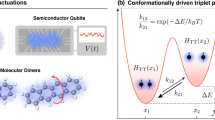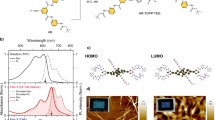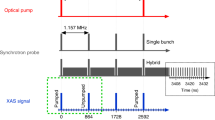Abstract
Singlet fission, in which two triplet excitons are generated from a single absorbed photon, is a key third-generation solar cell concept. Conservation of angular momentum requires that singlet fission populates correlated multiexciton states, which can subsequently dissociate to generate free triplets. However, little is known about electronic and spin correlations in these systems since, due to its typically short lifetime, the multiexciton state is challenging to isolate and study. Here, we use bridged pentacene dimers, which undergo intramolecular singlet fission while isolated in solution and in solid matrices, as a unimolecular model system that can trap long-lived multiexciton states. We combine transient absorption and time-resolved electron spin resonance spectroscopies to show that spin correlations in the multiexciton state persist for hundreds of nanoseconds. Furthermore, we confirm long-standing predictions that singlet fission produces triplet pair states of quintet character. We compare two different pentacene–bridge–pentacene chromophores, systematically tuning the coupling between the pentacenes to understand how differences in molecular structure affect the population and dissociation of multiexciton quintet states.
This is a preview of subscription content, access via your institution
Access options
Subscribe to this journal
Receive 12 print issues and online access
$209.00 per year
only $17.42 per issue
Buy this article
- Purchase on Springer Link
- Instant access to full article PDF
Prices may be subject to local taxes which are calculated during checkout






Similar content being viewed by others
References
Smith, M. B. & Michl, J. Singlet fission. Chem. Rev. 110, 6891–6936 (2010).
Tayebjee, M. J. Y., McCamey, D. R. & Schmidt, T. W. Beyond Shockley–Queisser: molecular approaches to high-efficiency photovoltaics. J. Phys. Chem. Lett. 6, 2367–2378 (2015).
Smith, M. B. & Michl, J. Recent advances in singlet fission. Annu. Rev. Phys. Chem. 64, 361–386 (2013).
Hanna, M. C. & Nozik, A. J. Solar conversion efficiency of photovoltaic and photoelectrolysis cells with carrier multiplication absorbers. J. Appl. Phys. 100, 74510 (2006).
Tomkiewicz, Y., Groff, R. P. & Avakian, P. Spectroscopic approach to energetics of exciton fission and fusion in tetracene crystals. J. Chem. Phys. 54, 4504–4507 (1971).
Tayebjee, M. J. Y., Clady, R. G. C. R. & Schmidt, T. W. The exciton dynamics in tetracene thin films. Phys. Chem. Chem. Phys. 15, 14797–14805 (2013).
Burdett, J. J., Gosztola, D. & Bardeen, C. J. The dependence of singlet exciton relaxation on excitation density and temperature in polycrystalline tetracene thin films: kinetic evidence for a dark intermediate state and implications for singlet fission. J. Chem. Phys. 135, 214508 (2011).
Burdett, J. J., Muller, A. M., Gosztola, D. & Bardeen, C. J. Excited state dynamics in solid and monomeric tetracene: the roles of superradiance and exciton fission. J. Chem. Phys. 133, 144506 (2010).
Wilson, M. W. B. et al. Temperature-independent singlet exciton fission in tetracene. J. Am. Chem. Soc. 135, 16680–16688 (2013).
Pope, M., Geacintov, N. E. & Vogel, F. Singlet exciton fission and triplet–triplet exciton fusion in crystalline tetracene. Mol. Cryst. Liq. Cryst. 6, 83–104 (1969).
Geacintov, N. E., Pope, M. & Vogel, F. Effect of magnetic field on fluorescence of tetracene crystals—exciton fission. Phys. Rev. Lett. 22, 593–596 (1969).
Piland, G. B. & Bardeen, C. J. How morphology affects singlet fission in crystalline tetracene. J. Phys. Chem. Lett. 6, 1841–1846 (2015).
Arias, D. H., Ryerson, J. L., Cook, J. D., Damrauer, N. H. & Johnson, J. C. Polymorphism influences singlet fission rates in tetracene thin films. Chem. Sci. 7, 1185–1191 (2016).
Pensack, R. D. et al. Exciton delocalization drives rapid singlet fission in nanoparticles of acene derivatives. J. Am. Chem. Soc. 137, 6790–6803 (2015).
Tayebjee, M. J. Y. et al. Morphological evolution and singlet fission in aqueous suspensions of TIPS-pentacene nanoparticles. J. Phys. Chem. C 120, 157–165 (2016).
Walker, B. J., Musser, A. J., Beljonne, D. & Friend, R. H. Singlet exciton fission in solution. Nat. Chem. 5, 1019–1024 (2013).
Stern, H. L. et al. Identification of a triplet pair intermediate in singlet exciton fission in solution. Proc. Natl Acad. Sci. USA 112, 7656–7661 (2015).
Burdett, J. J. & Bardeen, C. J. Quantum beats in crystalline tetracene delayed fluorescence due to triplet pair coherences produced by direct singlet fission. J. Am. Chem. Soc. 134, 8597–8607 (2012).
Musser, A. J. et al. Activated singlet exciton fission in a semiconducting polymer. J. Am. Chem. Soc. 135, 12747–12754 (2013).
Busby, E. et al. A design strategy for intramolecular singlet fission mediated by charge-transfer states in donor–acceptor organic materials. Nat. Mater. 14, 426–433 (2015).
Akdag, A. et al. Covalent dimers of 1,3-Diphenylisobenzofuran for singlet fission: synthesis and electrochemistry. J. Org. Chem. 80, 80–89 (2015).
Greyson, E. C. et al. Singlet exciton fission for solar cell applications: energy aspects of interchromophore coupling. J. Phys. Chem. B 114, 14223–14232 (2010).
Low, J. Z., Sanders, S. N. & Campos, L. M. Correlating structure and function in organic electronics: from single molecule transport to singlet fission. Chem. Mater. 27, 5453–5463 (2015).
Müller, A. M., Avlasevich, Y. S., Müllen, K. & Bardeen, C. J. Evidence for exciton fission and fusion in a covalently linked tetracene dimer. Chem. Phys. Lett. 421, 518–522 (2006).
Müller, A. M., Avlasevich, Y. S., Schoeller, W. W., Müllen, K. & Bardeen, C. J. Exciton fission and fusion in bis(tetracene) molecules with different covalent linker structures. J. Am. Chem. Soc. 129, 14240–14250 (2007).
Zeng, T. & Goel, P. Design of small intramolecular singlet fission chromophores: an azaborine candidate and general small size effects. J. Phys. Chem. Lett. 7, 1351–1358 (2016).
Korovina, N. V. et al. Singlet fission in a covalently linked cofacial alkynyltetracene dimer. J. Am. Chem. Soc. 138, 617–627 (2016).
Lukman, S. et al. Tuneable singlet exciton fission and triplet–triplet annihilation in an orthogonal pentacene dimer. Adv. Funct. Mater. 25, 5452–5461 (2015).
Sakuma, T. et al. Long-lived triplet excited states of bent-shaped pentacene dimers by intramolecular singlet fission. J. Phys. Chem. A 120, 1867–1875 (2016).
Sanders, S. N. et al. Quantitative intramolecular singlet fission in bipentacenes. J. Am. Chem. Soc. 137, 8965–8972 (2015).
Zirzlmeier, J. et al. Singlet fission in pentacene dimers. Proc. Natl Acad. Sci. USA 112, 5325–5330 (2015).
Sanders, S. N. et al. Intramolecular singlet fission in oligoacene heterodimers. Angew. Chem. 128, 3434–3438 (2016).
Rao, A., Wilson, M. W. B., Albert-Seifried, S., Di Pietro, R. & Friend, R. H. Photophysics of pentacene thin films: the role of exciton fission and heating effects. Phys. Rev. B 84, 195411 (2011).
Wilson, M. W. B. et al. Ultrafast dynamics of exciton fission in polycrystalline pentacene. J. Am. Chem. Soc. 133, 11830–11833 (2011).
Merrifield, R. E. Magnetic effects on triplet exciton interactions. Pure Appl. Chem. 27, 481–498 (1971).
Bayliss, S. L. et al. Geminate and nongeminate recombination of triplet excitons formed by singlet fission. Phys. Rev. Lett. 112, 238701 (2014).
Piland, G. B., Burdett, J. J., Kurunthu, D. & Bardeen, C. J. Magnetic field effects on singlet fission and fluorescence decay dynamics in amorphous rubrene. J. Phys. Chem. C 117, 1224–1236 (2013).
Bayliss, S. L. et al. Localization length scales of triplet excitons in singlet fission materials. Phys. Rev. B 92, 115432 (2015).
Congreve, D. N. et al. External quantum efficiency above 100% in a singlet-exciton-fission-based organic photovoltaic cell. Science 340, 334–337 (2013).
Jadhav, P. J., Mohanty, A., Sussman, J., Lee, J. & Baldo, M. A. Singlet exciton fission in nanostructured organic solar cells. Nano Lett. 11, 1495–1498 (2011).
Thompson, N. J., Hontz, E., Chang, W., Van Voorhis, T. & Baldo, M. Magnetic field dependence of singlet fission in solutions of diphenyl tetracene. Phil. Trans. R. Soc. A 373, 20140323 (2015).
Fünfschilling, J., Zschokkegranacher, I., Canonica, S. & Wild, U. P. Quantum beats in the fluorescence decay of tetracene crystals. Helv. Phys. Acta 58, 347–354 (1985).
Agostini, G., Corvaja, C., Giacometti, G. & Pasimeni, L. Optical, zero-field ODMR and EPR studies of the triplet-states from singlet fission in biphenyl-TCNQ and Biphenyl-Tetrafluoro-TCNQ charge-transfer crystals. Chem. Phys. 173, 177–186 (1993).
Yarmus, L., Rosenthal, J. & Chopp, M. EPR of triplet excitons in tetracene crystals—spin polarization and role of singlet exction fission. Chem. Phys. Lett. 16, 477–481 (1972).
Swenberg, C. E., van Metter, R. & Ratner, M. Comments on exciton fission and electron spin resonance in tetracene single crystals. Chem. Phys. Lett. 16, 482–485 (1972).
Sanders, S. N. et al. Exciton correlations in intramolecular singlet fission. J. Am. Chem. Soc. 138, 7289–7297 (2016).
Jeschke, G. & Spiess, H.-W. in Novel NMR and EPR Techniques (eds Dolinšek, J., Vilfan, M. & Žumer, S.) 21–63 (Springer, 2006).
Bencini, A. & Gatteschi, D. EPR of Exchange Coupled Systems (Springer, 1990).
Swenberg, C. E. & Geacintov, N. E. in Organic Molecular Photophysics Vol. 1 (ed. Birks, J. B.) Ch. 10 (Wiley-Interscience, 1973).
Snaathorst, D. & Keijzers, C. P. Triplet–triplet interactions between dimers of a copper maleonitriledithiolate complex. Mol. Phys. 51, 509–524 (1984).
Benk, H. & Sixl, H. Theory of two coupled triplet states. Mol. Phys. 42, 779–801 (1981).
Schweiger, A. & Jeschke, G. Principles of Pulse Electron Paramagnetic Resonance (Oxford Univ. Press, 2001).
Van Strien, A. J. & Schmidt, J. An EPR study of the triplet state of pentacene by electron spin-echo techniques and laser flash excitation. Chem. Phys. Lett. 70, 513–517 (1980).
Kumarasamy, E. et al. Properties of poly- and oligopentacenes synthesized from modular building blocks. Macromolecules 49, 1279–1285 (2016).
Zeng, T., Hoffmann, R. & Ananth, N. The low-lying electronic states of pentacene and their roles in singlet fission. J. Am. Chem. Soc. 136, 5755–5764 (2014).
Bakulin, A. A. et al. Real-time observation of multiexcitonic states in ultrafast singlet fission using coherent 2D electronic spectroscopy. Nat. Chem. 8, 16–23 (2016).
Musser, A. J. et al. Evidence for conical intersection dynamics mediating ultrafast singlet exciton fission. Nat. Phys. 11, 352–357 (2015).
Fuemmeler, E. G. et al. A direct mechanism of ultrafast intramolecular singlet fission in pentacene dimers. ACS Cent. Sci. 2, 316–324 (2016).
Feng, X. & Krylov, A. I. On couplings and excimers: lessons from studies of singlet fission in covalently linked tetracene dimers. Phys. Chem. Chem. Phys. 18, 7751–7761 (2016).
Stoll, S. & Schweiger, A. EasySpin, a comprehensive software package for spectral simulation and analysis in EPR. J. Magn. Reson. 178, 42–55 (2006).
Acknowledgements
This work was supported by the Australian Research Council (DP160103008 and LE130100146). M.J.Y.T. acknowledges receipt of an ARENA Fellowship and a Travel Award from the CASS Foundation. M.J.Y.T. thanks J. Behrends, R. Bittl and the Berlin Joint EPR Lab (BeJEL) for useful discussions. D.R.M. acknowledges an ARC Future Fellowship (FT130100214). L.M.C. acknowledges support from the Office of Naval Research Young Investigator Program (Award N00014-15-1-2532) and Cottrell Scholar Award. S.N.S. thanks the NSF for GRFP (DGE 11-44155). This research used resources of the Center for Functional Nanomaterials, which is a US DOE Office of Science Facility, at Brookhaven National Laboratory under Contract No. DE-SC0012704. We thank J. Guse for technical assistance.
Author information
Authors and Affiliations
Contributions
Experiments were designed and performed by M.J.Y.T., S.N.S., M.Y.S. and D.R.M. Materials were designed and synthesized by S.N.S., E.K. and L.M.C. Data were analysed by M.J.Y.T., S.N.S., M.Y.S. and D.R.M., and all authors contributed to the discussion. M.J.Y.T., S.N.S., M.Y.S. and D.R.M. wrote the manuscript, with contributions from all authors.
Corresponding authors
Ethics declarations
Competing interests
The authors declare no competing financial interests.
Supplementary information
Supplementary information
Supplementary information (PDF 2766 kb)
Rights and permissions
About this article
Cite this article
Tayebjee, M., Sanders, S., Kumarasamy, E. et al. Quintet multiexciton dynamics in singlet fission. Nature Phys 13, 182–188 (2017). https://doi.org/10.1038/nphys3909
Received:
Accepted:
Published:
Issue Date:
DOI: https://doi.org/10.1038/nphys3909
This article is cited by
-
Singlet fission initiating organic photosensitizations
Scientific Reports (2024)
-
Entangled spin-polarized excitons from singlet fission in a rigid dimer
Nature Communications (2023)
-
Quintet formation, exchange fluctuations, and the role of stochastic resonance in singlet fission
Communications Physics (2023)
-
Promoting multiexciton interactions in singlet fission and triplet fusion upconversion dendrimers
Nature Communications (2023)
-
Orbital-resolved observation of singlet fission
Nature (2023)



